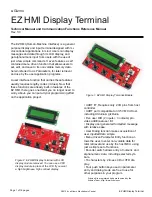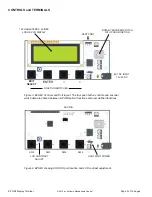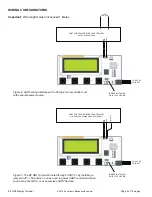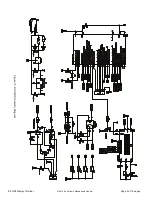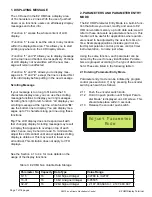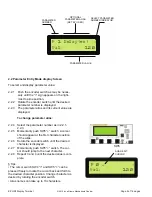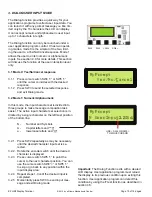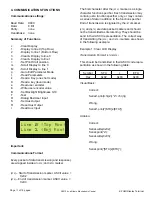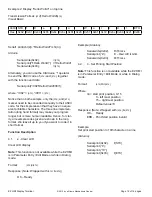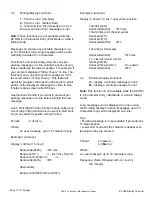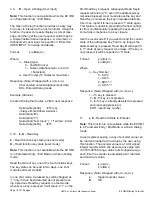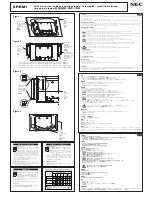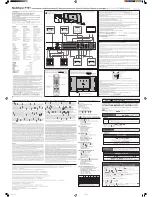
©2012 by e-Gizmo Mechatronix Central
N=L+"QU"18"QR"7=L+0
EZ HMI Display Terminal
3. DIALOG/USER INPUT MODE
&:+"G.=31L"8-2<;.12"7/1F.K+0"=",-.<M"P=4"81/"41-/"
applications programs to collect user input data. You
<=2"3=-2<:".;"P.;:"=24"7/197;"9+00=L+"41-"3.M+*"3.9
-
ited only by the 16 characters the LCD can display.
It can accept numeric and alphanumeric user input
up to 14 characters in length.
The Dialog function can only be launched under a
user application program control. It has two operat-
.2L"91K+0*"91K+"U".0";:+"0.973+/"18";:+";P1*"3.9.;
-
.2L";:+"-0+/";1"="m+0([1(D=2<+3"/+07120+T"C1K+"Q"
allows the user to enter numeric or alphanumeric
.27-;0T"]++"0+<;.12"YT^"81/"91/+"K+;=.30T"&:.0"0+<;.12"
will discuss the function at the user interaction level
only.
3.1 Mode 0: Yes/No/Cancel response
?TQTQ" N/+00"<-/01/"0P.;<:"]aY"ejf"1/"]aB"ekf"
until the cursor coincides with the desired
response.
?TQT5" N/+00"]a?";1"0+2K";:+"0+3+<;+K"/+07120+"
and exit Dialog mode.
3.2 Mode 1: Numeric/Alphanumeric
In this mode, the input character set is divided into
;:/++"L/1-70";1"9=M+"9+00=L+"<19710.;.12";=0M"
easier. The active input character set selection is in-
dicated by a single character on the leftmost position
of the bottom line:
"
["A"
[-9>+/"=2K"]49>130
"
$"A"
D=7.;=3"3+;;+/0"=2K"eopqrf
"
="A"
31P+/<=0+"3+;;+/0"=2K"estuf"
?T5TQT" N/+00"]a5"/+7+=;+K34"=0"9=4">+"2+<+00=/4"
until the desired character input set is se-
lected.
?T5T5T" %1;=;+";:+"+2<1K+/"0P.;<:"-2;.3";:+"K+0./+K"
character is displayed.
?T5T?" N/+00"<-/01/"0P.;<:"]aB"ekf";1"71.2;";:+"
cursor to the next character position. You can
-0+";:+"<-/01/"0P.;<:"]aY"ejf"1/"]aB"ekf"
;1"0M.7"1/"L1">=<M";1"=24"710.;.12"P.;:.2";:+"
input display area.
?T5TY" %+7+=;"0;+70"QA?"-2;.3";:+"K+0./+K".27-;".0"
completed.
?T5TB" C19+2;=/.34"7/+00"]a?";1"0+2K".27-;"9+0
-
sage and exit Dialog mode
MyPrompt
Yes/No/Cancel
_
]a5""""""]a?""""""j"]aY"""""]aB"k
MyPrompt
N UserInput
1234
_
USE < SW4 OR SW5>
TO MOVE CURSOR
Important:
&:+"G.=31L")-2<;.12"+c.;0"P.;:"="<3+=/+K"
LCD display. User application program must reload
the display to its previous condition upon exiting this
function. User application program can detect this
condition by using the
T
test function as described in
0+<;.12"YTBT

